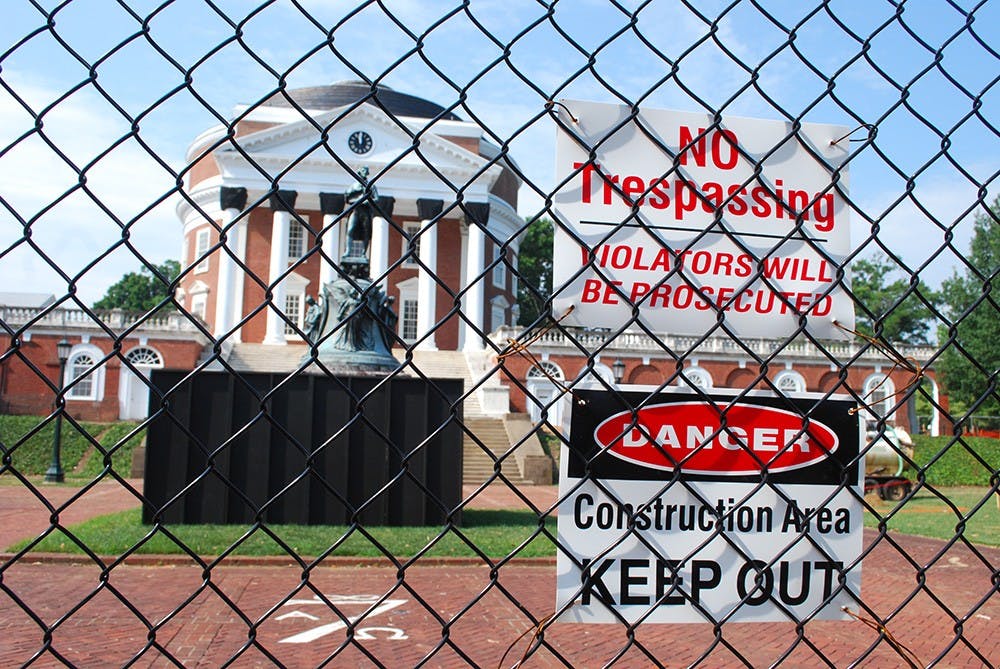The massive restoration project for Thomas Jefferson’s historic Rotunda continues as students and professors return for the fall semester. The beloved University landmark and UNESCO World Heritage Site has been fenced off since the conclusion of Final Exercises in May, making way for heavy duty construction equipment and teams of workers.
Major goals of the project — which began in 2012 and is now in “Phase Two” — include bringing the general utilities up to date and making the space more readily accessible to the University community. Phase Two is expected to be completed in Spring 2016 and cost $42.5 million.
Senior Historic Preservation Planner Brian Hogg said Phase Two of renovations includes extensive changes to the north and south porticoes, replacement of the capitals of the columns, repairs to the marble in the north stairs, new landscaping for the east and west courtyards and the north terrace, and improvement of the facilities and programming of the building.
“All of the building’s systems will be replaced and enhanced — power, data, HVAC [Heating, Ventilation and Air Conditioning], and the elevator,” Hogg said. “One of the biggest effects will not be a physical change, but a programming one.”
Hogg said the extensive renovation project was absolutely necessary, as the last major renovation took place in 1976.
“The roof leaked before last year’s work,” Hogg said. “The building systems were outdated, inefficient, lacked the wide variety of modern controls we now expect, and in some cases were unreliable.”
The University aims to make the Rotunda a more central facility to University life after this phase of renovations is complete.
“Last year the University undertook a pilot program of expanded classroom use and extended hours for student use and study,” Hogg said. “These efforts of increasing access and use to the building will be retained and expanded with additional study areas and expanded programming of the building.”
University Architect David J. Neuman also said the renovations aim to reinvigorate Jefferson’s original vision for the Rotunda as a centerpiece for education at the University — a vision that has dulled considerably since the library was moved from the Rotunda to Alderman Library in 1938.
“Jefferson intended the Rotunda to be the central focus of the Academical Village — not only physically by its size, location and architectural presence, but also programmatically by its function as the library and central classroom building that would be used daily by faculty and students,” Neuman said on the Rotunda webpage. “It is our intention to return the Rotunda to that central role.”
A significant amount of planning and purchasing has laid the groundwork for the remaining construction to come. Major demolition, underpinning, utility work and efforts to replace the capitals began this summer, accompanied by exciting historical discoveries.
University Conservator Mark Kutney said the renovations team found remains of the original Rotunda from before the fire of 1895, including a 12-inch thick layer of structural remains and pieces of metal, iron and glass that appear to be from the original building. Pieces of tin painted red were also found and are thought to be pieces from roofing shingles Jefferson was known to have used in his construction.
“We now have pieces of a large jigsaw puzzle that we have never had before,” Kutney said. “[We have] more information and knowledge of how Jefferson’s building was and how construction was at the time.”
These findings are significant, Kutney said, because of the Rotunda’s deep historical and cultural roots.
“As we move forward, we have to do more of this type of discovery work,” Kutney said. “From experience we know there is the potential to find additional information. … We have to be ready for it.”
Though the project is certainly extensive, Hogg and Stephen Ratliff, supervisory senior construction administration manager, said that restrictions that the renovations place on student life and University traditions would be limited.
“Great effort has been taken to minimize the effect of the work, both in terms of the daily life of the University and in terms of accommodating the special events that occur during the school year,” Hogg said. “But it’s a big, important project that people will be — and should be — aware of.”
Hogg said this year’s Lawn residents should not fear the disruptions. “They will have the unique experience of a front-row seat for the once-in-a-lifetime renovation of a World Heritage Site.”







